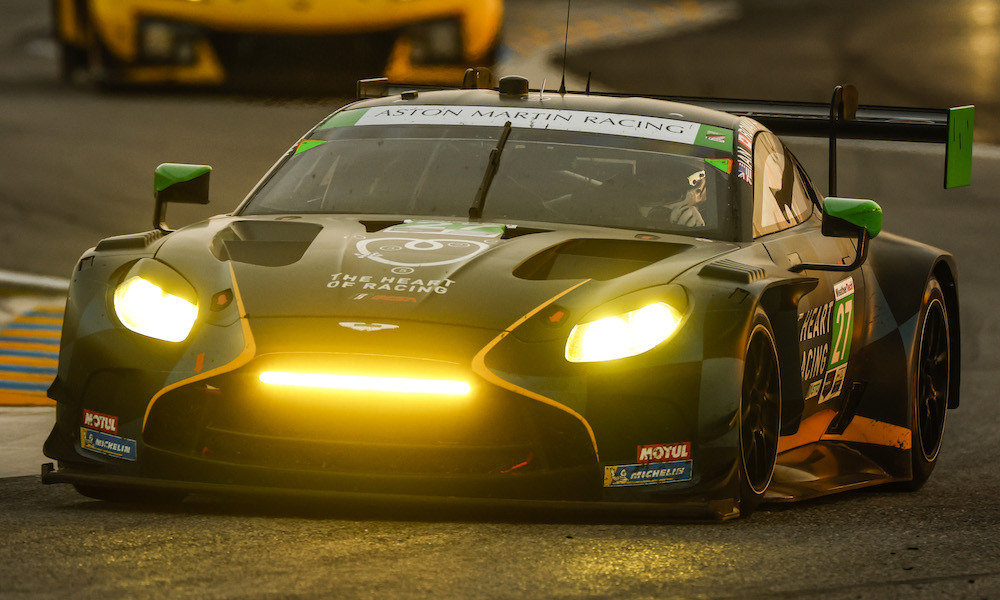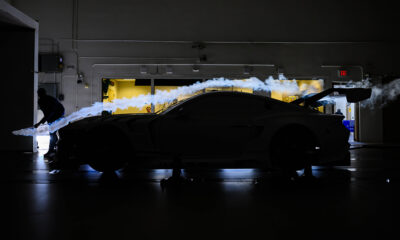
Photo: Mike Levitt/IMSA
Aston Martin placed a focus on widening the setup window on its updated, new-for-2024 Vantage GT3, with Head of Endurance Motorsport Adam Carter stating the Evo kit allowed the brand to focus on the “shortcomings of the previous car.”
The British manufacturer officially unveiled the latest iteration of its GT3 platform on Monday after the car already made its competitive debut at the Rolex 24 at Daytona in the hands of The Heart of Racing and Magnus Racing.
First announced in October, Carter previously told Sportscar365 that Aston Martin aimed to make the new car more accessible for gentleman drivers, which was an area where the car previously lacked.
Carter outlined to a group of reporters gathered at Daytona how exactly the brand aimed to make those improvements
“The GT3 car had got itself into a bit of a position where it formed from the GTE car and taken over some kind of behaviors where it made it a little bit more tricky for the amateurs,” Carter explained.
“In GT3 with a Pro-Am kind of combination in there, the Ams would struggle on it. It had quite a small setup window.
“In particular, there’s all of that lap time available in kind of braking and turning at that entry point, and the previous generation GT3 car could be [tricky].
“Not all times, because sometimes an Am would be on it, but they’d go to the next event and they’d just be out of the window, and it would be that tricky at that kind of turning point.
“The new Vantage GT3 is very much directed around actually [having a] wider setup window and [being] more drivable.”
Carter explained that suspension and aerodynamics are two key areas where gains have been sought and made, which should present drivers with more balance through corners.
“The front suspension geometry has changed, rear suspension geometry has changed and the aero has significantly changed, as you can see from the car,” he said.
“As part of that change there’s some reasonably subtle changes combining that kind of front suspension geometry with aero, platform, etcetera to make it less, let’s say less fickle on that kind of entry turn in phase.
“With that, what was happening before because it was nervous in that kind of condition, you would make setup changes, and then make it slightly more tricky on the exit as well.
“So to try and calm it down on the entry, you’re trying to then balance and compromise. Race cars are always a sum of the parts, nothing comes for free.
“It’s always moving it around and so you ended up effectively compounding the issue, so also the car’s now better actually in traction as well, more stable on exit.”
Carter said Aston Martin has changed ’85 sub-components across the car’ while also focusing on areas like the throttle pedal setup, brakes and brake cooling.
Critically, as the car is an evolution of the existing design and not an entirely new car, some of the major underpinnings have remained unchanged.
That means the new Vantage GT3 is still powered by the same twin-turbocharged V8 engine that has been in the car since 2018, while Carter also described a “a large amount of underlying carryover” in other areas.
“The gearbox is the same, differential spec has changed slightly, it’s very wide-reaching from some of the electrical sensors, some of the hardware,” he said.
“But the actual ultimate part, because it is homologated as an Evo, you can take the previous GT3 car and upgrade.
“The chassis, the engine, gearbox, etc all there, so there’s a large amount of underlying carryover to it.”
Aston Martin has taken steps to hop on the trend of increasingly modular front and rear end assemblies on GT3 machinery, which was particularly pioneered by the Ferrari 296 GT3 that debuted last year.
Carter stated that the car has a ‘clipped, quick change kind of front’ that will allow for faster nose changes in case of damage.
“I would say it’s quicker change than the previous car,” he said. “They’re all quicker than let’s say a road car but it’s definitely done to be much more serviceable a lot quicker.
“It is a front engine car so it’s not going to be the same as the 296, whatever that kind of clipped architecture.
“But it is there and we’ve got a better mechanism to allow fast change rear wing angle etcetera as well.
“BoP racing is about execution. You have a car, you do the best job you can with the car, you look for a good attributes in order to say drivability get that setup window in there.
“But it’s also about team execution things as well, so that is also considered because that’s a race time attribut. Not only for issues just actual in session tuning as well.”























